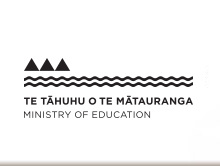Ko Wai te Toa?
nā Rona Lawson
He Whakarāpopototanga
Tokorua ngā tamariki e tākaro ana i tētahi momo mahi ā-ringa. Ka hē tētahi, ā, ka toa tētahi.
Summary
Two children are playing a simple hand game. One child makes a mistake and the other child wins.
| Te momo reo tuhi Language style |
|
|---|---|
| Ētahi āhuatanga o tēnei momo reo tuhi Features of this language style |
|
I te Ākonga e Pānui Ana
During Reading
Titiro ki te uhi o mua:
1. E aha ana rāua?
2. Titiro ki a rāua tahi. Ki ōu whakaaro, e pēhea ana ō rāua kare ā-roto?
3. Pānuitia mai te taitara o te pūrākau nei, ki ōu whakaaro, he aha te kaupapa o tēnei kōrero?
4. Ki ōu whakaaro, ko wai te toa?
Look at the cover of the book:
1. What are the characters doing?
2. Look at the characters' faces. How do you think they are feeling?
3. Read the title of the story. Are there any clues in the title that might help you to determine what this story might be about?
4. Who do you think the winner is?
Pānuitia ngā whārangi 2–5:
1. Matapakihia ngā kiripuaki i ngā whakaahua. E hia pea ō rāua tau?
2. E aha ana rāua? He aha i mahi pērā ai rāua me ō rāua matimati?
3. He pai tēnei kēmu ki te tokorua nei? Nā te aha koe i whakaaro pēnā ai?
Read pages 2–5:
1. Discuss the characters in the pictures. How old do you think they might be?
2. What are they doing? Why are they using their fingers like that?
3. Do they like playing this game? What makes you think so?
Pānuitia ngā whārangi 6–8:
1. Titiro ki te pikitia. He aha tāu e kite ana?
2. Ki ōu whakaaro, ko wai ka toa? He aha ai?
3. He tīwhiri anō i roto i ngā pikitia?
4. Me tākaro tātau ināianei. Ki ōu whakaaro ko wai ka toa?
Read pages 6–8:
1. Look at the picture. What can you see happening?
2. Who do you think will win? Why?
3. Are there any clues in the pictures that help you to come to that conclusion?
4. Let’s play! Who do you think will win?
I Muri i te Pānui Pukapuka
After Reading
Te Whakahihiko Hinengaro
He ngohe ēnei e pā ana ki ngā kōrero i roto i ngā pukapuka katoa, arā, Ko Wai te Toa?, Kia Tūpato Marama!, Poutoti, me Ōku Ringaringa. Ka taea e te pouako ēnei te whakamahi kia tutuki ngā whāinga whakaako me ngā whāinga ako. Mā te pouako ēnei ngohe e whakahāngai ki ngā whāinga ako me ngā hiahia o ngā ākonga.
Ia rā waiatahia te waiata Te Arapū Māori. Hoatu he kāri arapū ki ngā tamariki, mā rātou e whakaraupapa ā-arapū mai. Hei āwhina, ka whai pea i te raupapa o tētahi arapū kua tuhia ki te papatuhituhi, kua whakairihia rānei ki te pakitara.
Prompting Ideas
These are some ideas for learning which may be used in connection with the books Ko Wai te Toa?, Kia Tūpato Marama!, Poutoti, and Ōku Ringaringa, that pouako can use to help achieve their teaching purposes. These ideas can be adapted as required to suit the learning objectives and needs of the students.
Practise the song Te Arapū Māori. Give the students a set of alphabet cards to sort into alphabetical order. To help them, they could follow the alphabet written on the board or have an alphabet frieze on the wall.
Anei ētahi mahi hei āwhina pea i ngā ākonga kia mārama haere ki ngā ariā o te pukapuka.
1. Tukuna ngā ākonga kia hanga i ētahi atu mahi ā-ringa e whakamārama ana i ngā kupu whakahau kua whakamahia i roto i te pukapuka nei, arā, ko te toro me te piko.
2. Tuhia te kōrero o te pukapuka ki runga kāri. Hoatu ngā kāri ki ngā ākonga. Ko tā rātou mahi, he whakaraupapa i ngā kāri kia tika ai te raupapa o te kōrero.
3. Tāruatia te kōrero me te pikitia ki runga kāri. Kutia, kia noho motuhake te kōrero me te pikitia. Ko tā te ākonga mahi, he hono i te kōrero ki te pikitia tika.
4. Tukuna ngā ākonga kia tāia he pikitia mō tētahi wāhanga o te pukapuka, kātahi ka kōrero mō taua pikitia. Mā te kaiako te kōrero a te ākonga e tuhi ki runga i tana pikitia.
Here are some activities which may help students learn the concepts in the book.
1. Allow students to create other games using the active verb commands toro and piko.
2. Write the text on cards. Give the cards to the students. Students will sequence the sentences in the order that they appear in the text.
3. Photocopy the text and pictures on to card. Cut these so that the text and pictures are separate. The students match up the correct text with the correct pictures.
4. Get students to draw a picture about a part of the book, and then talk about their picture. The teacher then writes what the student has said on his/her picture.






